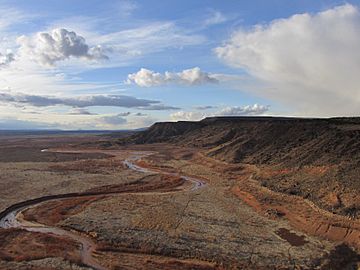San Felipe volcanic field facts for kids
Quick facts for kids San Felipe volcanic field |
|
|---|---|

Jemez River at the south end of the volcanic field
|
|
| Highest point | |
| Elevation | 1,585 to 1,950 meters (5,200 to 6,398 ft) |
| Geography | |
| Location | New Mexico, United States |
| Geology | |
| Age of rock | 2.5 million years |
| Mountain type | Volcanic field |
| Volcanic arc/belt | Rio Grande Rift |
The San Felipe volcanic field (also called the Santa Ana Mesa field) is a special area in New Mexico, United States. It's a place where many small volcanoes erupted a long time ago. This field is found just north of where the Jemez River joins the Rio Grande.
Contents
What is the San Felipe Volcanic Field?
This volcanic field is made up of lava flows that came from cracks in the ground called fissures. Most of these lava flows erupted from long cracks and openings that lined up from north to south.
The biggest of these cracks created the San Felipe shield volcano. A shield volcano is a type of volcano that looks like a warrior's shield lying on the ground, with gentle slopes. San Felipe volcano is about 6,434 meters (21,109 ft) high. It rises about 800 feet (240 m) above the flat ground where the lava first spread out.
How Big is the Volcanic Field?
The lava flows from these eruptions cover an area of about 38 square miles (98 km2). When the eruptions happened, about 2.5 million years ago, the land was quite flat. Over millions of years, the land around the volcanic field has worn away. This means the volcanic field now stands high up like a flat-topped hill, called a mesa. The hard basalt rock from the lava flows forms the top of this mesa. It can be as much as 1,000 feet (300 m) above the Jemez River.
What Else Can You Find There?
Besides the San Felipe volcano, there are three other main eruption spots. Scientists have also found 66 cinder cones in the field. Cinder cones are cone-shaped hills made from volcanic ash and rocks. These cinder cones are also lined up close to cracks in the Earth's surface called faults. These faults show that the ground has moved up to 350 feet (110 m).
It's interesting that many of these cinder cones are now almost flat or look like shallow bowls on the lava flows. This probably happened because nearby rivers flowed over the lava after the eruptions. The rivers wore down the cinder cones before the whole area was lifted higher above the river level. Some cinder cones also have "ring dikes," which are small, circular rock formations. These, along with other small rock plugs, formed during the last stages of the eruptions.
Important Volcanic Spots
Here are some of the notable places where eruptions happened in the San Felipe volcanic field:
| Name | Height | Location | Last eruption |
|---|---|---|---|
| Canjilon Hill | 1,615 meters (5,299 ft) | 35°21′40″N 106°32′17″W / 35.361°N 106.538°W | - |
| San Felipe Peak | 6,434 meters (21,109 ft) | 35°28′16″N 106°29′31″W / 35.471°N 106.492°W | 2.5 Mya |

